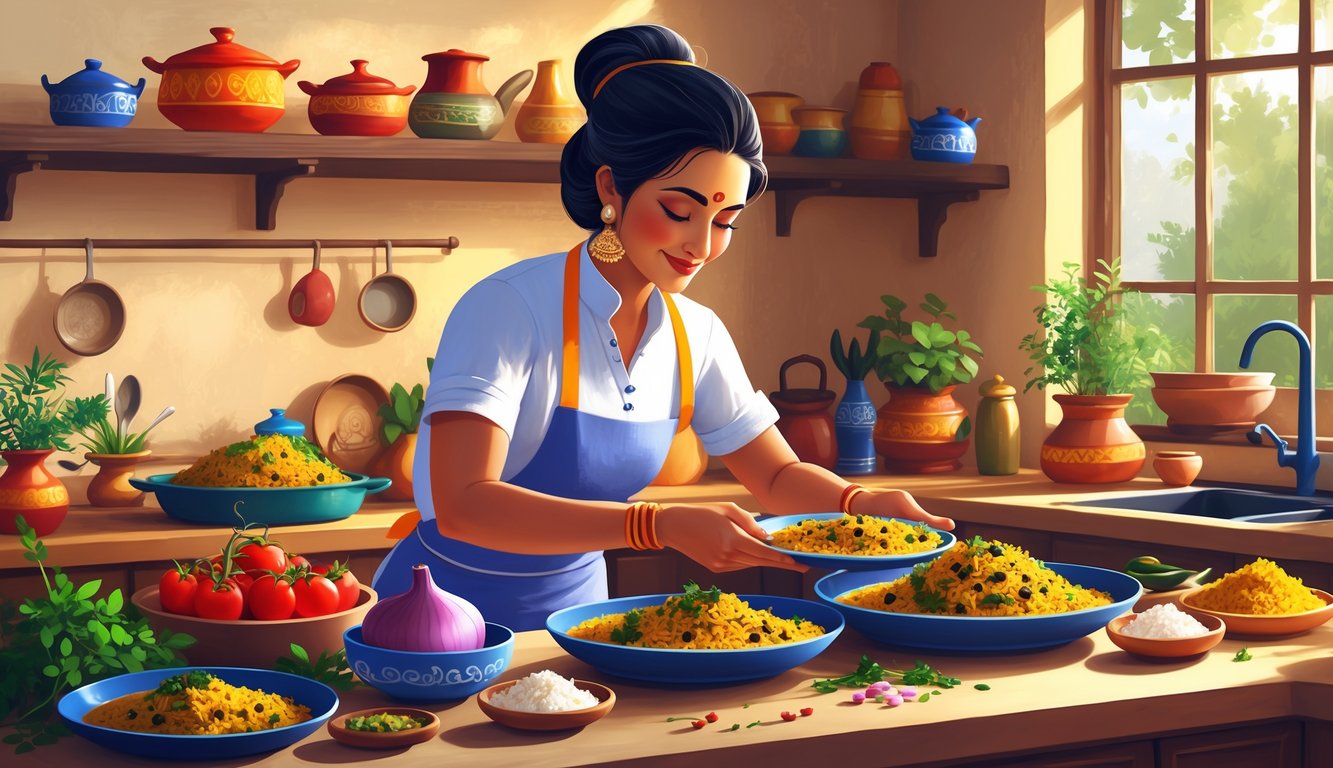
Sourcing the Best Ingredients for Authentic Flavors
Fifteen types of cumin at the store—whole, ground, organic, what’s the difference? My cart’s full and I still have nothing. It’s all about the ingredients, right? I’ve ruined biryani with the wrong rice or missing one spice more times than I’ll admit.
Shopping for Indian Pantry Staples
Nobody warns you: skip the regular grocery aisle. Go to the specialty Indian store or a legit online shop. Every decent Indian kitchen—home or restaurant—relies on turmeric, cumin, coriander, mustard seeds, green cardamom, and way too much dal. See “curry powder”? Run. Shiva Natarajan says stick with IndianBlend or iShopIndian. Supermarket spices are a gamble.
It took me years, but whole spices, ground as needed, stored in glass—life-changing. Masala dabba (that round spice box) is the only “gadget” that’s actually useful. And fenugreek isn’t lettuce. Asafoetida (hing) smells wild but makes sambar and dal fry taste right.
Choosing the Right Rice and Grains
I’ve tried six “basmati” brands and finally just ordered a 10-pound bag online. Did a taste test—restaurant biryanis use aged basmati, at least two years, super-long grains. If the rice clumps, it’s not biryani. The magic of biryani is in the grain separation and aroma, which only real basmati gives.
Brown rice? Doesn’t fit, except in things like pongal. Dal isn’t one thing—masoor, toor, chana, each does its own thing. Every region throws in its own curveball: poha out west, idli rice down south. Quinoa? Tried it, not convinced.
Finding Quality Produce and Proteins
“Fresh coriander” at the regular store is always 90% stem, zero leaves. South Asian markets have real coriander, curry leaves, bitter gourd that actually lasts. Okra can’t be floppy. Pre-cut onions are a sad mistake—flavorless and mushy.
Store-bought paneer? Not even close to Delhi dhaba stuff. I make it or find it fresh. Meat’s tricky: goat or lamb from halal butchers, chicken thighs for curries, not breasts. Pork’s rare, but it sneaks in sometimes. Seafood for southern recipes? Flash-frozen, wild-caught shrimp or kingfish if I get lucky.
Basically, if the ingredient’s not at its best, everything tastes flat. Chefs, old family cooks—they all say the same thing. Shortcuts show.
Frequently Asked Questions
I flip chapatis at midnight, but my kitchen never smells like the tandoor next to the pharmacy. And somehow, even the most neon chicken tikka turns bland if I forget fenugreek. Chefs and home cooks go on about patience, spice blends, and why onions need time. I tried rushing onions once. The smoke alarm still hates me.
What are the secrets to making authentic Indian dishes at home?
Supposedly, double the onions and simmer everything at glacial speed. Hari Ghotra swears her restaurant-style recipes work with supermarket spices. I’m skeptical, but whatever. Leena from Pune told me, “Cut corners on garlic? Just eat cereal.” Fair.
Tempering (tadka) goes in last. Burn mustard seeds and your day’s ruined. If you can’t smell five things at once, something’s off.
How can I recreate the flavors of my favorite Indian restaurant meals in my kitchen?
Grind fresh spices when you should be getting ready for work. Add more ghee than your doctor would ever allow. Restaurant curries? Start with vats of pureed onions, apparently. Reddit says onions matter more than any spice. Someone used six in one curry.
I forget the pre-cooked base sauce trick every time. Everyone else swears by it. My neighbor says, “It’s just MSG.” I can’t prove him wrong.
Which spices are essential for traditional Indian cooking at home?
Ran out of cumin seeds on a Sunday—ruined everything. Turmeric stains, but does nothing without coriander. Cardamom’s always missing when I need it. Skipped asafetida (hing) once—my aunt texted me for hours.
Restaurant-style flavor is all about the right mix of whole and ground spices. Guides always list cumin, coriander, garam masala, turmeric, mustard seeds, chili powder. That last one? Careful, it’ll betray you. Curry powder’s a lie.
Can you suggest some healthy Indian recipes that are beginner-friendly?
My first chana masala was a burnt mess. But apparently, even beginners can manage dal, tandoori chicken, Bombay Aloo—if you don’t drown them in cream. I stole “oven-roasted cauliflower with cumin” from a dietician. It’s basically just cumin.
If you want less oily, family-friendly stuff, go for tomato-based dals and grilled meats, not the creamy restaurant dishes. Online cookbooks have loads of options that don’t need a deep fryer. Blender’s optional.
How do I balance spices and flavors in homemade Indian cuisine?
Honestly? I just add yogurt if things get out of hand and pretend I meant to. Balancing tangy, salty, bitter, sweet, spicy—it’s supposed to be precise, but one wrong move and everything tastes like a forest. Ask three grandmas, get three answers.
Chefs say taste every ten minutes, change one thing at a time. The real difference between home and restaurant food? Less oil, more careful balancing, and don’t trust “secret spice blends” unless you grind them yourself.
What are some tips for cooking Indian meals more efficiently at home?
Honestly, who decided kitchens should have, like, one square foot of usable counter space? I’ve tried stacking three pans on a single burner—yeah, don’t do that unless you enjoy chaos. Maybe you’re one of those people who preps everything on Sunday, chopping a mountain of onions and roasting spices while pretending you’re on a cooking show. I keep telling myself I’ll do it, but then Sunday comes and I’m just, I don’t know, eating cereal and scrolling TikTok. Still, when I actually bother, it saves me from those “why isn’t dinner ready yet?” stares.
Pressure cookers? They’re magic, but also, let’s be honest, they sound like they’re about to explode. Dals in 20 minutes, though—worth the anxiety? Maybe. I don’t know.
Restaurants, those sneaky geniuses, batch-cook their gravies and just nuke them to order. Does that mean I should make a giant pot of tomato-onion base, freeze it, and pretend I’m running a tiffin service? I’ve tried. It’s weirdly satisfying but also feels like cheating. Whatever, weeknight me is grateful.
And planning? Ugh, I hate it. But the number of times I’ve sprinted to the store for cilantro halfway through a recipe—yeah, should probably get my act together. Or not.



